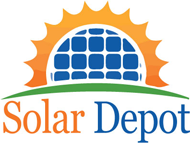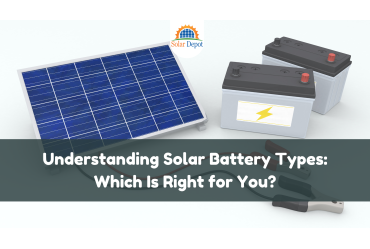Understanding Solar Battery Types: Which Is Right for You?
Understanding Solar Battery Types: Which Is Right for You?
Solar batteries are essential to maximizing the efficiency of your solar energy system, especially in areas where reliable electricity is crucial. Choosing the right battery type can help you save on energy bills, keep your lights on during outages, and even achieve energy independence. However, with various solar battery types available, it’s important to understand their differences to make an informed choice.
In this guide, we’ll explore the most common types of solar batteries—lithium—ion, Lithium Iron Phosphate (LFP), and Lead-acid—and outline their benefits and drawbacks to help you decide which is best for your specific energy needs.
Why Solar Batteries Are Essential
Solar batteries store the excess energy produced by solar panels, allowing you to use stored power when the sun isn’t shining or during outages. A reliable solar battery:
Increases energy independence
Reduces reliance on the grid
Provides backup power during blackouts
Optimizes solar panel efficiency
With these benefits in mind, let’s dive into the primary solar battery types today.
Key Types of Solar Batteries
1. Lithium-Ion Batteries
Overview: Lithium-ion batteries are among the most popular choices for solar energy storage due to their high energy density, long lifespan, and low maintenance requirements. These batteries are lightweight and capable of holding more energy in a smaller space, making them an excellent choice for both residential and commercial solar systems.
Pros:
High Energy Density: Packs a significant amount of energy into a compact size.
Longer Lifespan: Can last between 10–15 years with proper maintenance.
Efficiency: High round-trip efficiency, often over 90%.
Low Maintenance: Requires minimal upkeep.
Cons:
Higher Initial Cost: Generally more expensive than other battery types.
Temperature Sensitivity: Performance can decline in extreme temperatures if not properly protected.
Ideal For: Homes and businesses looking for a long-lasting, space-efficient battery. The upfront cost is higher, but the benefits over time make it a solid investment.
2. Lithium Iron Phosphate (LFP) Batteries
Overview: LFP batteries are a subset of lithium-ion batteries, but they use lithium iron phosphate as the cathode material, which makes them safer and more stable. Known for their exceptional thermal stability, LFP batteries are a preferred choice in areas with high temperatures or where safety is a priority.
Pros:
Safety: Very stable and less prone to overheating or catching fire.
Longevity: Can endure up to 20 years with proper care.
High Efficiency: Like other lithium batteries, LFP offers over 90% efficiency.
Environmental Impact: More eco-friendly than traditional lithium-ion due to its non-toxic materials.
Cons:
Lower Energy Density: This may require more physical space for the same capacity.
Higher Upfront Cost: Costs more initially compared to Lead-acid batteries.
Ideal For: Individuals in warmer climates or those prioritizing safety and longevity. Many residential and commercial users choose LFP batteries for their resilience and environmental benefits.
3. Lead-Acid Batteries
Overview: Lead-acid batteries are among the oldest and most affordable battery options. They come in two main types—flooded lead-acid and sealed lead-acid (including AGM and gel types). While less efficient than lithium options, lead-acid batteries are widely used for off-grid solar systems and backup power.
Pros:
Lower Cost: Generally more affordable than lithium options.
Availability: Easily accessible and widely used in various industries.
Recyclable: Lead-acid batteries are recyclable, adding an eco-friendly aspect.
Cons:
Shorter Lifespan: Typically lasts 3–5 years, requiring frequent replacement.
Lower Efficiency: Lower round-trip efficiency compared to lithium-ion and LFP batteries.
Maintenance: Flooded lead-acid batteries need regular maintenance and water refilling.
Ideal For: Budget-conscious users or those with off-grid systems who don’t mind more frequent replacements. Ideal for occasional or backup use, lead-acid batteries are effective for short-term or low-capacity needs.
Comparing Solar Battery Types: A Quick Overview
How to Choose the Right Battery Type for Your Needs
When selecting a solar battery, consider the following factors:
Energy Needs
Determine your average energy usage and whether you need a battery for backup, daily use, or high-capacity storage.
Budget
Higher-cost batteries (like lithium-ion) offer better performance and longevity, while lead-acid is budget-friendly but has a shorter lifespan.
Space Availability
If you have limited space, a high-energy-density option like lithium-ion may be best.
Climate Conditions
In hot climates, consider LFP batteries for their thermal stability.
Intended Use
Choose a durable, efficient battery type for daily power use. For occasional or backup use, a lead-acid battery may suffice.
Recommended Solar Batteries from Solar Depot NG
1. Dyness BX51100 LFP Battery
Capacity: 5.12kWh, 51.2V
Type: Lithium Iron Phosphate (LFP)
Ideal For: Homes and businesses in hot climates looking for long-lasting power.
2. Dyness Powerbox Pro LFP Battery
Capacity: 10kWh, 51.2V
Type: Lithium Iron Phosphate (LFP)
Ideal For: High-capacity needs with reliable, stable energy storage.






